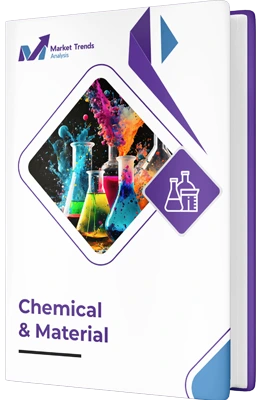
The 2,3-Butanediol market was valued at approximately USD 350 Million in 2024 and is projected to reach USD 620 Million by 2033, exhibiting a compound annual growth rate (CAGR) of around 7.2% from 2025 to 2033. This growth trajectory reflects increasing industrial adoption driven by technological advancements and expanding applications across multiple sectors. The market's expansion is also supported by rising investments in sustainable chemical manufacturing and regulatory support for bio-based solutions. As industries seek greener alternatives, the demand for bio-derived 2,3-Butanediol is expected to accelerate, reinforcing its strategic importance in the global chemical landscape.
2,3-Butanediol is a colorless, viscous, and hygroscopic diol with the chemical formula C4H10O2. It is a key intermediate in the production of synthetic rubber, plastics, and solvents. Naturally, it is produced via microbial fermentation of sugars, making it a prominent bio-based chemical. Its unique properties include high boiling point, low volatility, and excellent solvent capabilities, which make it suitable for diverse industrial applications. The compound also exhibits potential as a precursor for advanced materials, pharmaceuticals, and biofuels, positioning it as a versatile platform chemical in the evolving green economy.
The 2,3-Butanediol market is witnessing a paradigm shift driven by industry-specific innovations and sustainability initiatives. The integration of bio-based production processes is gaining momentum, aligning with global regulatory pushes for environmentally friendly chemicals. Market players are increasingly investing in R&D to develop high-yield fermentation techniques and novel catalysts, enhancing process efficiency. The rising demand from end-use sectors such as automotive, textiles, and healthcare is further propelling market growth. Additionally, strategic collaborations and acquisitions are shaping a competitive landscape focused on technological leadership and market penetration strategies.
Several core drivers underpin the robust growth of the 2,3-Butanediol market, notably the global push for sustainable chemicals and bio-based alternatives. The rising demand for eco-friendly solvents and intermediates in manufacturing processes is catalyzing industry adoption. Additionally, advancements in microbial fermentation technology have significantly improved production yields, reducing costs and enhancing scalability. The expanding application scope across sectors such as plastics, pharmaceuticals, and biofuels further fuels market momentum. Regulatory frameworks favoring green chemistry and corporate sustainability commitments are also pivotal in accelerating market penetration.
Despite promising growth prospects, the 2,3-Butanediol market faces several restraints that could impede expansion. High production costs associated with bio-based fermentation processes remain a significant challenge, impacting overall profitability. The lack of standardized quality benchmarks and regulatory uncertainties in certain regions hinder widespread adoption. Additionally, competition from synthetic chemical routes and alternative intermediates limits market share growth. Technical complexities related to process scalability and purity levels also pose operational hurdles. Market volatility driven by fluctuating raw material prices and geopolitical factors further constrains long-term strategic planning.
The evolving landscape of the 2,3-Butanediol market presents numerous opportunities driven by technological, regulatory, and consumer trends. The shift toward bio-based and renewable chemicals offers avenues for market expansion, especially in regions with supportive policies. Innovations in fermentation technology and genetic engineering are poised to reduce costs and improve yields, unlocking new applications. The rising demand for sustainable plastics and biodegradable materials further enhances growth prospects. Additionally, strategic collaborations with biotech firms and investments in green chemistry R&D can accelerate commercialization. Emerging markets in Asia-Pacific and Latin America represent untapped potential for market penetration and diversification.
Looking ahead, the 2,3-Butanediol market is set to evolve into a cornerstone of the bio-based chemical industry, driven by innovations in microbial engineering and sustainable manufacturing. Its future applications will extend into advanced materials, biodegradable plastics, and high-performance solvents, aligning with global sustainability goals. The integration of smart manufacturing solutions and Industry 4.0 technologies will enhance process efficiencies and product quality. As regulatory landscapes tighten around petrochemical reliance, bio-derived 2,3-Butanediol will become increasingly vital for compliant, eco-friendly product portfolios. The market's trajectory points toward a more decentralised, bio-centric supply chain that emphasizes circular economy principles and consumer-driven demand for green products.
2,3-Butanediol Market was valued at approximately USD 350 Million in 2024 and is projected to reach USD 620 Million by 2033, growing at a of 7.2% from 2025 to 2033.
Growing emphasis on sustainable and bio-based chemicals, Technological innovations in microbial fermentation, Expanding application spectrum across industries, Regulatory incentives promoting green manufacturing, Increasing consumer demand for environmentally friendly products, Strategic investments by key industry players are the factors driving the 2, 3-Butanediol Market.
The Top players operating in the 2, 3-Butanediol Market are Jiangsu Sopo Corporation, Shandong Qilu Petrochemical Group, Green Biologics, Fujian Shaowu Huasheng Pharmaceutical, BioAmber Inc., Genomatica, Reverdia (a DSM and Roquette joint venture), Jiangsu Lianmeng Chemical Technology, Shandong Jinan Yuxin Chemical, Evonik Industries, Arkema Group, Eastman Chemical Company, Yancheng Hongtai Chemical, NatureWorks LLC, Celanese Corporation.
2,3-Butanediol Market is segmented based on Source, Application, End-Use Industry And Geography.
The sample report for the 2,3-Butanediol Market can be obtained on demand from the website. Also, the 24*7 chat support & direct call services are provided to procure the sample report.